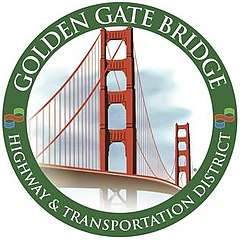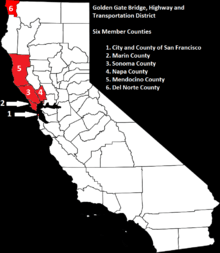Golden Gate Bridge, Highway and Transportation District
 | |
| Government agency | |
| Founded | 4 December 1928 |
| Headquarters | San Francisco |
Area served | San Francisco Bay Area |
| Services | Transportation |
| Revenue | $217.8 million (FY 2010-2011) |
Number of employees | 800 |
| Website | http://www.goldengate.org |
The Golden Gate Bridge, Highway and Transportation District is a special-purpose district that owns and operates three regional transportation assets in the San Francisco Bay Area:
History and responsibilities
The District was incorporated on 4 December 1928 as the Golden Gate Bridge and Highway District to design, construct, and finance the Golden Gate Bridge. The responsibility of regional transit service within the Golden Gate Corridor was given to the District on 10 November 1969, and the District was given its current name at this time.[1]
The District's territory includes the City and County of San Francisco; Marin, Sonoma, and Del Norte counties; and large portions of Napa and Mendocino counties. The only other county along the California North Coast, Humboldt County, declined to join the district after its residents opposed the bridge's construction, fearing that the increase in tourists and newcomers would disrupt the local redwood lumber industry and various cattle and sheep ranches.[2]

The District provides regional bus and ferry transit service throughout the Golden Gate Corridor, which runs from San Francisco to Sonoma County. The District does not operate transit service in Napa, Mendocino, or Del Norte counties. Within Marin County, Golden Gate Transit is the contractor for a majority of bus service provided by Marin Transit, a relationship that dates to 1971.[3] Golden Gate Transit has operated bus service across the Richmond-San Rafael Bridge to Contra Costa County on behalf of the Metropolitan Transportation Commission since 1993.
The District's primary revenue source is tolling on the southbound lanes of the Golden Gate Bridge. A mix of tolls, transportation subsidies, and grants is used to support bus and ferry services.[4]
Governing structure
The District has a 19-member board of directors:[5]
- Nine Directors represent San Francisco
- One is appointed by the Mayor
- Four are elected members of the Board of Supervisors
- Four are non-elected people appointed by the Board of Supervisors
- Four Directors represent Marin County
- Two are elected members of the Board of Supervisors
- One is an elected member of the Council of Mayors and Councilmembers and is appointed by the Board of Supervisors
- One is a non-elected person appointed by the Board of Supervisors
- Three Directors represent Sonoma County
- One is an elected member of the Board of Supervisors
- One is an elected member of the Council of Mayors and Councilmembers and is appointed by the Board of Supervisors
- One is a non-elected person appointed by the Board of Supervisors
- One Director each represent Napa, Mendocino, and Del Norte counties
- Each is a non-elected person appointed by the respective Boards of Supervisors
The District is headquartered in San Francisco; it has administrative offices in San Francisco and San Rafael.
Two members of the board are also serve on the Sonoma–Marin Area Rail Transit board of directors[6] and operations are coordinated between the two agencies.
References
- ↑ Key Dates
- ↑ "Special District Formed - Golden Gate Bridge and Highway District". Retrieved 2013-03-16.
- ↑ Golden Gate Transit Timeline
- ↑ "Adopted Budget: Fiscal Year 2011-2012" (PDF). Golden Gate Bridge, Highway and Transportation District. Retrieved 16 December 2011.
- ↑ Board Member Biographies
- ↑ "Assembly Bill 2224" (pdf). Retrieved 2017-04-10.